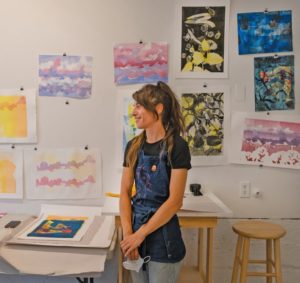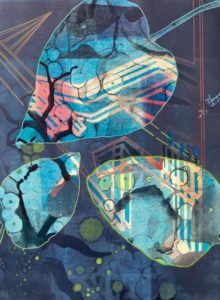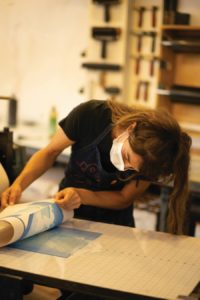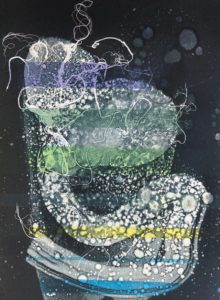The term “emerging artist” is often used without much thought about what it means. In a sense, artists should always be “emerging.” But there’s a moment where the process is most acute. It’s like a butterfly struggling to break free from its chrysalis, emerging in its colorful glory but not yet in flight.

The term seems appropriate for Dominique Pecce. She’s not a hobbyist, yet she’s still striving to establish herself as a working artist. She’s committed to a technique — printmaking — and working to further develop her skills while experimenting in different styles.
Historically, the Outer Cape has been a place that nurtured young artists. Charles Webster Hawthorne opened the Cape Cod School of Art in Provincetown in 1899 and established the town as an art colony. Other influential teachers would continue to draw in young people to develop into mature artists who would profoundly shape American culture.
Ross Moffett first came to Provincetown from Iowa in 1913. He writes about arriving with his friend Henry Sutter: “When our train reached Provincetown, Sutter and I walked to the Jennings Dining Room where, for thirty cents each, we had our first Provincetown meal. We then located the offices of the Hawthorne Art Class, and from there, we were directed to the house of Mrs. Dora Drisco, where for $3.00 a week we enjoyed a room with a kitchenette and facilities for preparing our own food.” (Of course, it would be unthinkable today for a young art student to show up at the beginning of the summer and so easily find affordable accommodations.)
Moffett returned the following year: “When Sutter and I returned … we took Studio Number 2 in a row of new studios that had just been built at Days Lumber Yard on Pearl Street. These studios, which rented for $50.00 a year, were unfurnished, and we had to build bunks and collect, here and there, a minimum of the furnishings we found necessary.”

The studios at Days Lumber Yard, where Moffett lived until 1917, continue to be used as work spaces for young artists: the Fine Arts Work Center (FAWC), founded in 1968, purchased the building in 1972 as part of an effort to preserve Provincetown as an art colony. Even then, rising costs associated with tourism were a concern. According to a history of the center provided to its board members, “by the ’50s and ’60s, America’s first and foremost art colony … was in steep decline. The cost of living rose relentlessly. Tourism atomized all values … The rule of economics was absolute: artists were being forced out by high summer rents, kept out in the winter by lack of jobs. The gallery scene slipped toward eclipse. Schlock art flourished.” Sound familiar? (Note: some historians dispute the claim that Provincetown was America’s first art colony.)
FAWC’s signature program has been a seven-month residency for which 10 visual artists and 10 writers are chosen to live and work in Provincetown. They receive housing, studio space, and a modest stipend. The influence of these artists on American culture has been significant, with past fellows going on to win Guggenheim and MacArthur fellowships and awards including the Pulitzer Prize and the Nobel Prize in Literature. Many more have led modest careers of quiet and sustained devotion to their craft, including a number who have remained on the Cape and nurtured the local creative community.
FAWC has thrived in part because of its exclusivity: this year, 20 fellows were selected from a pool of 1,500 applicants. The center’s summer program accommodates a larger audience, typically hosting 500 to 600 participants each season in writing and visual arts workshops. Roughly half of the center’s revenue is raised from its summer classes. A typical one-week class costs $800, plus an additional $1,000 for accommodations. Ironically, FAWC remains out of reach for many of the emerging artists it was designed to serve and is no longer the refuge from gentrification its founders envisioned. It’s unlikely that a young Ross Moffett would find himself there.
Or maybe he would.
At 35, Dominique Pecce isn’t the same age as Moffett when he arrived in Provincetown — but she’s in a similar place. An Outer Cape native (she grew up in Truro), Pecce had always been familiar with the Fine Arts Work Center. “It’s a facility I passed frequently and longed to go in,” she said. An opportunity arose this summer when she won two scholarships to printmaking classes at the center. She said she would have been “priced out” if it weren’t for the scholarships.

It’s fitting that Pecce received this help, as generosity is central to her ethos as an artist. I first met her at a sad art fair in Provincetown that hardly anyone attended. My daughter, six at the time, was with me, and the two struck up a conversation, eventually trading artworks: my daughter’s brightly painted seashell for one of Pecce’s rocks with an intricately drawn design. Later, Pecce made my daughter a kaleidoscope. On a walk in the woods in Wellfleet, my wife found another rock of Pecce’s — this one with a miniature drawing of a nude figure — left for someone to find.
Pecce’s artwork defies easy categorization. Aside from her kaleidoscopes and drawings on rocks, she typically works two dimensionally in a graphic, linear style. In the work she created at FAWC, color became an important focus. (“Color meeting color is new for me,” Pecce said.) And although she works across mediums, printmaking is her primary passion. But getting access to a printmaking shop has been a challenge.
“Print shops are expensive and hard to come by,” said Pecce. “I’m unable to afford both rent and studio rent.” She periodically used the press at Castle Hill in Truro during the off season but found it hard to cover the fees to use the facility. Last winter, determined not to let finances hinder her practice, Pecce began applying for scholarships in earnest and received awards from Castle Hill, the Penland School of Craft in North Carolina — and the Fine Arts Work Center.
“The scholarships give me a sense of validation in my long pursuit to be an artist on Cape Cod,” said Pecce. “Making sure we still have a place to grow is so vital. It’s hard to come by. It’s so nice when it comes from the community.” Thanks to the scholarships, Pecce was able to sideline her day jobs, which have included driving a taxi, working at Salty Market, and installing artwork at Rice Polak Gallery. “I thought if I got a majority of the scholarships, I would need to treat myself and my work differently,” she said. “It was a hard choice to take myself out of the workforce. But the time is now. I feel like I’m not waiting to be an artist.”

Pecce’s experience at FAWC was made possible by a program that provides scholarships to Cape residents in addition to two dozen other scholarships. “Many of them are specifically for young people, or people with economic hardship, or people of color,” said Programs Director David Simpson. “They are specifically meant to increase the diversity of people taking workshops.” This past summer about 10 percent of the workshops’ total enrollment were scholarship recipients. “Executive Director Sharon Polli and I came with a commitment to make the center as welcoming to as wide a range of people as possible,” said Simpson, whose recent appointment closely followed Polli’s appointment and represented a major shift in leadership. But he admits that “the dominant demographic in the summer programs is pretty self-evident. It’s white people in their 50s and 60s with the means to attend. There is work to do.”
It’s unclear how much a place like the Fine Arts Work Center could expand its scholarship program to stave off the erosion of opportunities for emerging artists on the Cape. “A nonprofit needs to raise money,” said Simpson, explaining the center’s reliance on summer programs as a source of revenue. For those like Pecce who are able to access the programs, the experience can be pivotal. Yet economic challenges — especially related to housing — can seem unsurmountable for those who want to remain on the Cape.
Earlier this year, Pecce applied for a research position at a nontoxic printmaking center in western Massachusetts. Shortly after, she lost her housing in Truro. “I’ve been driving around my whole life seeing empty houses and having nowhere to live,” she said. “It’s a painful truth.”
With no local housing prospects and an opportunity in a more affordable region with consistent access to a print shop, the decision to relocate was easy. “I’m packing my bags,” she said. “I’m spending my last days here as a practicing artist. I’m grateful to the people who gave me chances. I wouldn’t be as far as I am without their support and encouragement.”
But she hasn’t given up on the Cape just yet. “If I keep advancing in my education, I can bring new and safer techniques back here,” she said. “I want to be in the shop sharing knowledge. I promise to come back with a heavily loaded tool belt. I feel like doors are opening, and I’m confident to walk through them.”
